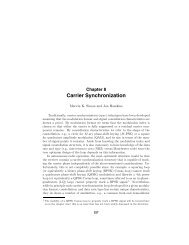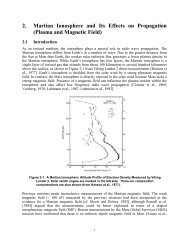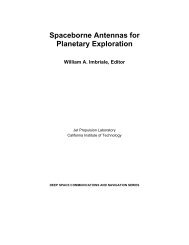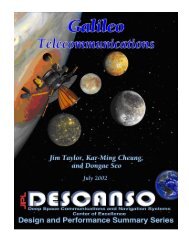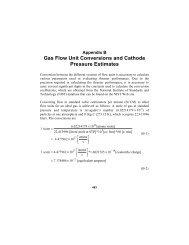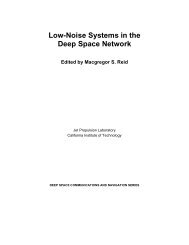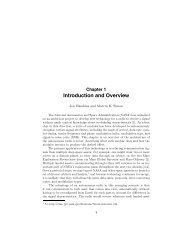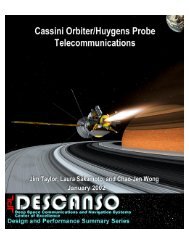Propagation Effects Handbook for Satellite Systems - DESCANSO ...
Propagation Effects Handbook for Satellite Systems - DESCANSO ...
Propagation Effects Handbook for Satellite Systems - DESCANSO ...
Create successful ePaper yourself
Turn your PDF publications into a flip-book with our unique Google optimized e-Paper software.
6.5.2 Amplitude Fluctuations<br />
6.5.2.1 Overview. The phenomena of amplitude and angle-of-arrival<br />
fluctuations combine to <strong>for</strong>m received signal amplitude fluctuations.<br />
For many cases of propagation one or more of these effects may often<br />
be neglected. For example, a receiving system which employs an<br />
antenna with a wide beamwidth will not experience angle-of-arrivalinduced<br />
amplitude fluctuations <strong>for</strong> most elevation angles. However,<br />
such simplification is not always possible. The theory of wave<br />
propagation and scattering in random media allows a combination of<br />
the turbulence induced effects to be per<strong>for</strong>med in the context of<br />
weak fluctuations along a line-of-sight path. The work of Ishimaru<br />
(1978), which defines coherent and incoherent field components as a<br />
plane wave propagates through a random medium, provides a method of<br />
combining amplitude and angle-of-arrival effects into a model of<br />
received signal amplitude fluctuation. A model utilizing the<br />
concept of incident plane wave decomposition (see Figure 6.6-1) has<br />
been proposed by Theobold and Hedge (1978).<br />
6.5.2.2 Variance of Received Signal Amplitude. The assumption of<br />
weak turbulence is invoked <strong>for</strong> a plane wave incident on a region of<br />
turbulence, propagating a distance Lt (km) and impinging on a<br />
circular aperture of diameter da (meters). The antenna is assumed to<br />
have a Gaussian pattern function with half-power beamwidth B<br />
(degrees). If vd is the received signal voltage, assuming a<br />
square-law first mixer? an expression <strong>for</strong> signal variance relative<br />
to average power is<br />
S2 = 10 IO!J,*<br />
where<br />
(dd<br />
~2>.~>2<br />
U 2<br />
~*>2<br />
11=’<br />
= lolog,o<br />
- exp [-Lt/Lo]<br />
Ic =(1 - Ii) /(1+0;)<br />
1<br />
(IC012 + “62<br />
= electric field amplitude variance<br />
6-76<br />
‘-‘i (27$2+ J<br />
5.55~2 + B<br />
‘c+ ‘i (27$2+ ~)<br />
(6.5-1)





